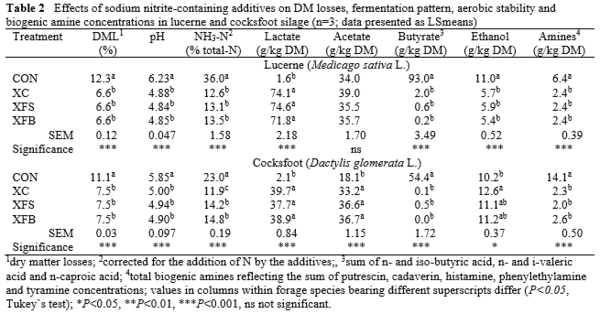Effects of Different Sodium Nitrite-Containing Additives on Dry Matter Losses, Fermentation Pattern and Biogenic Amine Formation in Lucerne and Cocksfoot Silage
Published: September 8, 2017
By: AUERBACH, H. 1, NADEAU, E. 2, WEISS, K. 3, THEOBALD, P. 4
/ 1 International Silage Consultancy, Wettin-Löbejün, Germany; 2 Swedish University of Agricultural Sciences, Department of Animal Environment and Health, Länghem, Sweden; 3 Humboldt Universität zu Berlin, Faculty of Life Sciences, Berlin, Germany; 4 University Nürtingen-Geisslingen, Department of Animal Nutrition and Health, Nürtingen, Germany.
Introduction
Sodium nitrite (SN) has been widely used in Europe as a component of silage additives that strongly inhibits clostridia. As SN is rapidly converted to nitric oxides and ammonia during the early fermentation phase, this compound is applied in combination with other chemicals, which prevent clostridia development during later stages of the fermentation process. Those substances can be hexamethylene tetramine (HMT), sodium benzoate and potassium sorbate (Bader, 1997). The aim of this study was to test as to whether the most important co-substance of SN in chemical silage additives - HMT - can be replaced by a combination of formate with either sodium benzoate or potassium sorbate in difficult-to ensile materials, such as low dry matter (DM) lucerne and cocksfoot, without compromising the inhibiting effects on clostridia even for extended periods of anaerobic storage.
Materials and Methods
Forages were cultivated on the research farm of University Nürtingen-Geisslingen, Germany, mowed by a plot harvester before budding (lucerne, Medicago sativa L.) and before heading (cocksfoot, Dactylis glomerata L.) respectively, in early June 2015. After raking by hand in the field, forages were wilted under a roof for about one day and subsequently chopped by a stationary chopper to about 30 mm theoretical cutting length. After additive application, three replicates of 1.5 L glass jars per treatment were filled and stored at 20 °C for 314 days (lucerne) and 313 days (cocksfoot), respectively. In addition to a control treatment (CON) and the commercially available product Xtrasil classic (XC, 245 g/kg sodium nitrite, 165 g/kg hexamethylene tetramine), two proprietary new blends composed of sodium nitrite and formate/sorbate (XFS) or formate/benzoate (XFB) were tested. All products were obtained from KONSIL Europe GmbH and applied at 3 l/t. All additives were diluted with tap water to give an application rate of 10 ml/kg fresh forage which was manually sprayed onto the forage. The control treatment received 10 ml of tap water per kg fresh forage. Chemical analysis of the fresh herbage was performed according to the official German standards for feed evaluation. The DM of silages was measured and corrected for the loss of volatiles during drying (Weissbach and Kuhla, 1995). An HPLC method was used to analyze lactic acid, and volatile fatty acids and alcohols were determined by GC. Biogenic amines were detected by GC-MS/MS. Losses of DM during fermentation were calculated according to Weissbach (2005). Statistical analyses were performed by using the procedures GLM and REG of SAS. Differences between least-square (LS) means were tested by Tukey`s test, and significance declared at P<0.05.
Results and Discussion
Both forages had typical protein and fibre values for first cut materials (Table 1). However, ash content exceeded the recommended maximum content of 100 g/kg DM, and water-soluble carbohydrate concentrations were much lower than previously reported by Weissbach and Auerbach (2012). Especially the markedly increased buffering capacity, which was most likely caused by the high ash content due to raking by hand, rendered the forages difficult-to-ensile as the fermentability coefficients were below 35 (Weissbach and Auerbach, 2012).

Fermentation losses were reduced by silage additives in both forage species, and differences between additive treatments were not observed (Table 2). This is in line with observations on other sodium nitrite-containing additives (Reuter and Weissbach, 1991; Knicky and Spörndly, 2010). Untreated silages underwent excessive clostridial fermentations as demonstrated by high concentrations of butyric acid due to anaerobic decomposition of lactic acid, as well as by extremely high ammonia levels (Kaiser et al., 1997). The activity of clostridia was largely restricted by the additives with butyric acid concentrations never exceeding 3 g/kg DM, which is the threshold value for good silage quality set by the German Agricultural Society (DLG, 2006). The formation of acetic acid remained unaffected by treatment in lucerne silage but the additives increased its concentration in cocksfoot silage. Ethanol formation in lucerne silage was suppressed by all treatments, whereas the additive XC increased its concentration when compared with untreated cocksfoot silage. Decarboxylation of amino acids to biogenic amines by clostridia was strongly reduced by additive use, and the resulting values were always lower than typical concentrations of less than 5 g/kg DM in wellfermented silages (Richardt, 2012).

Across forage species, there existed a strong polynomial relationship between the concentrations of butyric acid and ammonia-N (y=0.16x2+0.91x+13.3, R2=0.97, P<0.001). Moreover, biogenic amine concentrations were closely related with those of butyric acid (lucerne: R2=0.91, P<0.001; cocksfoot: R2=0.99, P<0.001) and ammonia-N (lucerne: R2=0.86, P<0.001; cocksfoot: R2=0.90, P<0.001) respectively, but the slopes and intercepts for the linear models differed between lucerne and cocksfoot silage.
Conclusions
Fermentation quality of lucerne and cocksfoot silages ensiled at low DM was very poor and elevated concentrations of biogenic amines were detected in untreated silages. The use of sodium nitrite-containing additives – regardless of the co-substances in the mixture - resulted in excellent fermentation quality and also reduced biogenic amine formation to normal levels even after extended periods of storage for about ten months. It seems possible to replace HMT by combinations of formate/sorbate or formate/benzoate in silage additive preparations without compromising their inhibitory effect on clostridia growth. More studies, including large scale ensiling trials, are under way.
Presented at the 17th International Conference Forage Conservation, Horný Smokovec, Slovak Republic, 2016.
References
- Bader, S. (1997): Möglichkeiten zur Steuerung des Gärungsverlaufes bei der Grünfuttersilierung durch kombinierte Anwendung biologischer und chemischer Zusätze. Landbauforschung Völkenrode Sonderheft 176, 1-110.
- DLG (2006): Grobfutterbewertung. Teil B-DLG-Schlüssel zur Beurteilung der Gärqualität von Grünfuttersilagen auf der Basis der chemischen Untersuchung [Roughage evaluation. Part B-DLG scheme for evaluating fermentation quality of silages on the basis of chemical analyses]. DLG-Information 2/2006. http://2015.dlg.org/fileadmin/downloads/fachinfos/futtermittel/grobfutterbewertung_B.pdf.
- Kaiser, E., Weiss, K. and Zimmer, J. (1997): Zum Gärungsverlauf bei der Silierung von nitratarmem Grünfutter. 1. Mitteilung: Gärungsverlauf in unbehandeltem Grünfutter [On the course of fermentation in low-nitrate forages. 1th part: The course of fermentation in untreated forage]. Arch. Anim. Nutr. 50, 87-102.
- Knicky, M. and Spörndly, R. (2010): Ensiling capability of a mixture of sodium benzoate, potassium sorbate, and sodium nitrite. Journal Dairy Science 94, 824-831.
- Reuter, B. and Weissbach, F. (1991): Results of testing chemical preservatives. Landbauforschung Völkenrode Sonderheft 123, 338-341.
- Richardt, W. (2012): Silage quality and animal health. In: Auerbach, H., Lückstädt, C. and Weissbach, F. (Eds.): Proceedings of the 1th International Silage Summit. ISBN 978-0-9573721-6-0, 43-66.
- Weissbach, F. (2005): A simple method for the correction of fermentation losses measured in laboratory silos. In: Park, R. S. and Stronge, M. D. (Eds): Proceedings XIVth International Silage Conference, July 2005, Belfast, Northern Ireland, 278.
- Weissbach, F. and Kuhla, S. (1995): Substance losses in determining the dry matter content of silage and green fodder: Arising errors and possibilities of correction. Übersichten Tierernährung 23, 189-214.
- Weissbach, F. and Auerbach, H. (2012): The future of forage conservation. In: Auerbach, H., Lückstädt, C. and Weissbach, F. (Eds.): Proceedings of the 1th International Silage Summit. ISBN 978-0-9573721-6-0, 5-42.
Related topics:
Authors:
ADDCON
Recommend
Comment
Share

Would you like to discuss another topic? Create a new post to engage with experts in the community.







.jpg&w=3840&q=75)